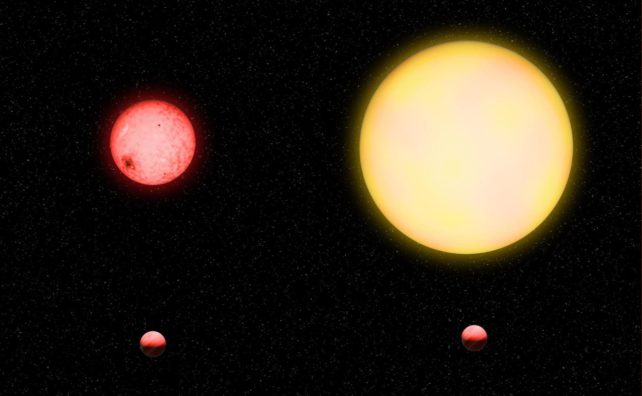There are a lot of weird and wonderful planets outside the Solar System, but a newly discovered world is a real space oddity.
Exoplanet TOI-5205b is a gas giant about the same size and mass as Jupiter, orbiting the red dwarf TOI-5205. But there's nothing unusual about that; planets orbit stars all the time.
What is unusual is TOI-5205's size compared to the Jupiter-sized exoplanet. The star is not quite four times its planet's radius, clocking in just under 40 percent of the radius and mass of the Sun. Moreover, TOI-5205b's orbit is uncomfortably close, traveling around the red dwarf once every 1.6 days.
This is one of the first times such a large exoplanet has been found orbiting such a tiny red dwarf, and astronomers haven't figured out how such a strange pairing came to be. It flies in the face of our current understanding of planet formation.
"The host star, TOI-5205, is just about four times the size of Jupiter," says astronomer Shubham Kanodia of the Carnegie Institution for Science, "yet it has somehow managed to form a Jupiter-sized planet, which is quite surprising."
Red dwarf stars are the smallest main sequence stars that we know of; any smaller and we start veering into brown dwarf not-quite-stars territory. They're low mass, brightness, and heat, burning through their hydrogen stores so slowly that their projected lifespans can be in the trillions of years, way longer than the current 13.8 billion-year age of the Universe.
Because they're so small and dim, red dwarfs can't be seen with the naked eye; yet they're the most numerous stars in the Milky Way. However, of the 5,250 exoplanets confirmed at the time of writing, just 240 are orbiting red dwarf stars; only about a dozen or so of those are Jupiter-sized or larger.
What we understand about planet formation suggests that such star-exoplanet pairings are unlikely. Stars form from clumps in dense clouds of gas and dust. As they grow, the material around them coalesces into a disk that feeds into the baby star, a bit like water swirling down a drain. Once the star is massive enough, it emits powerful winds that blow the closest material away, cutting off the star's growth.
What's left in this disk then forms objects that orbit the star, clumping together to gradually grow into planets. To make a gas giant, our current modeling suggests that about 10 Earth masses of rocky disk material are required to make the planetary core, which then accumulates gas to create a giant extended atmosphere. This process must happen relatively quickly, too, before the baby star blasts the remnants of the disk away.
Our models also suggest that a tiny red dwarf star shouldn't have enough material in its disk for this process to occur within the required timeframe.

"TOI-5205b's existence stretches what we know about the disks in which these planets are born," Kanodia says.
"In the beginning, if there isn't enough rocky material in the disk to form the initial core, then one cannot form a gas giant planet. And at the end, if the disk evaporates away before the massive core is formed, then one cannot form a gas giant planet. And yet TOI-5205b formed despite these guardrails. Based on our nominal current understanding of planet formation, TOI-5205b should not exist; it is a 'forbidden' planet."
The exoplanet was discovered based on transits, which is when an orbiting world passes between us and its host star. This passage dims the star's light; if the star's intrinsic brightness is known, astronomers can calculate the exoplanet's size. The gravitational interaction between the star and the exoplanet also causes the star to "wobble" slightly on the spot, and measuring this wobble allows astronomers to calculate the exoplanet's mass.
Based on these observations, Kanodia and his team found that the exoplanet is 1.08 times the mass and 1.03 times the radius of Jupiter. It's 27.2 percent of the radius of the star, which is 39.4 and 39.2 percent of the mass and radius of the Sun, respectively.
This seems extreme, but even more fascinatingly, TOI-5205b is not alone. A paper recently uploaded to the preprint server arXiv and accepted for publication details the discovery of TOI-3235b, an exoplanet 0.665 times the mass and 1.07 times the radius of Jupiter, orbiting a red dwarf 0.394 times the mass and 0.37 times the radius of the Sun, with a period of 2.6 days.
And in 2021, astronomers announced the discovery of TOI-519b, a gas giant up to 14 times the mass and 1.07 times the radius of Jupiter, orbiting a red dwarf 0.37 times the mass and radius of the Sun, with a period of 1.27 days.
So these exoplanets can exist, if rarely. It will be up to future work to figure out how. Luckily, the transits of these exoplanets can help.
Light from the star changes as it passes through the exoplanet's atmosphere; with a powerful infrared telescope such as JWST, those changes can be examined in minute detail to determine what these atmospheres are made of.
Perhaps they will also contain some clues leading to this fascinating mystery's resolution.
The research has been published in The Astronomical Journal.
https://news.google.com/rss/articles/CBMiW2h0dHBzOi8vd3d3LnNjaWVuY2VhbGVydC5jb20vdGhpcy1wbGFuZXQtaXMtd2F5LXRvby1iaWctdG8tYmUtb3JiaXRpbmctdGhpcy10ZWVueS10aW55LXN0YXLSAQA?oc=5
2023-02-25 23:00:46Z
CBMiW2h0dHBzOi8vd3d3LnNjaWVuY2VhbGVydC5jb20vdGhpcy1wbGFuZXQtaXMtd2F5LXRvby1iaWctdG8tYmUtb3JiaXRpbmctdGhpcy10ZWVueS10aW55LXN0YXLSAQA
Bagikan Berita Ini















0 Response to "This Planet Is Way Too Big to Be Orbiting This Teeny Tiny Star - ScienceAlert"
Post a Comment